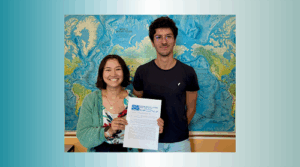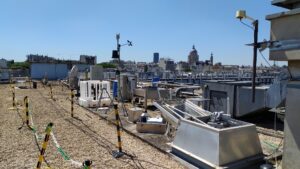Soutenance de thèse
Eleftherios Ioannidis
LATMOS
Local and remote sources of Arctic air pollution
Résumé
The Arctic region is warming faster than any other region on Earth due to the effect of greenhouse gases, notably CO2, and short-lived climate forcers of anthropogenic origin, such as black carbon (BC). Over the last 20-30 years, remote anthropogenic emissions over mid-latitude regions have been decreasing. Anthropogenic emissions within the Arctic are also contributing and might increase in the future and further affect Arctic air pollution and climate. Natural emissions, such as sea-spray aerosols, also might increase due to on-going climate change. However, the processes and sources influencing Arctic aerosols and trace gases are poorly quantified, especially in wintertime.
In this thesis, quasi-hemispheric and regional simulations are performed using the Weather Research Forecast model, coupled with chemistry (WRF-Chem). The model is used to investigate atmospheric composition over the wider Arctic and during two field campaigns, one in northern Alaska at Barrow, Utqiaġvik in January and February 2014 and the second in Fairbanks, central Alaska in November and December 2019 during the French pre-ALPACA (Alaskan Layered Pollution And Chemical Analysis) campaign.
First, modelled inorganic and sea-spray (SSA) aerosols are evaluated at remote Arctic sites during wintertime. Then, the model is improved with respect to SSA treatments, following evaluation against Barrow field campaign data, and their contribution to the total aerosol burden within the Arctic region is quantified. A series of sensitivity runs are performed over northern Alaska, revealing model uncertainties in processes influencing SSA in the Arctic such as the presence of sea-ice and open leads. Second, a sensitivity analysis is performed to investigate processes and sources influencing wintertime BC over the wider Arctic and over northern Alaska, with a focus on removal treatments and regional emissions. Variations in model sensitivity to wet and dry deposition are found across the Arctic and could explain model biases. Over northern Alaska, regional emissions from petroleum extraction are found to make an important contribution to observed BC.
Model results are also sensitive to planetary boundary layer parameterisation schemes. Third, the improved version of the model is used to investigate the contribution of regional and local sources on air pollution in the Fairbanks area in winter 2019. Using up-to-date emissions, the model performs better in winter 2019 than in winter 2014, when compared to observations at background sites across Alaska. Underestimations in modelled BC and sulphate aerosols can be partly explained by lacking local and regional anthropogenic emissions. In the case of sulphate, additional secondary aerosol formation mechanisms under dark/cold conditions also need to be considered.
Informations supplémentaires
En présentiel
Sorbonne Université – Campus Pierre et Marie Curie
4, place Jussieu 75005 PARIS
Salle de Conférences de l’UFR TEB – Tour 46-56, 2e étage
À distance
Participer à la réunion Zoom
https://us02web.zoom.us/j/82574537857?pwd=dHJIZDN2TTU3UnlDd1Q0NTlSVFRtUT09
ID de réunion : 825 7453 7857
Code secret : 215360
Composition du jury
- Solène Turquety – LATMOS (Présidente du Jury)
- Stephen Arnold – University of Leeds, Leeds, England, United Kingdom (Rapporteur)
- Virginie Marecal – Centre national de la recherche scientifique (CNRS) & Météo-France, Toulouse, France (Rapportrice)
- Barbara D’Anna – CNRS/Université d’Aix-Marseille, Marseille, France (Examinatrice)
- Matthias Beekman – Institut Pierre-Simon Laplace, Laboratoire Interuniversitaire des Systèmes Atmosphériques, Université Paris-Est Créteil, France (Examinateur)
- Kathy Law – LATMOS (Directeur de thèse)






